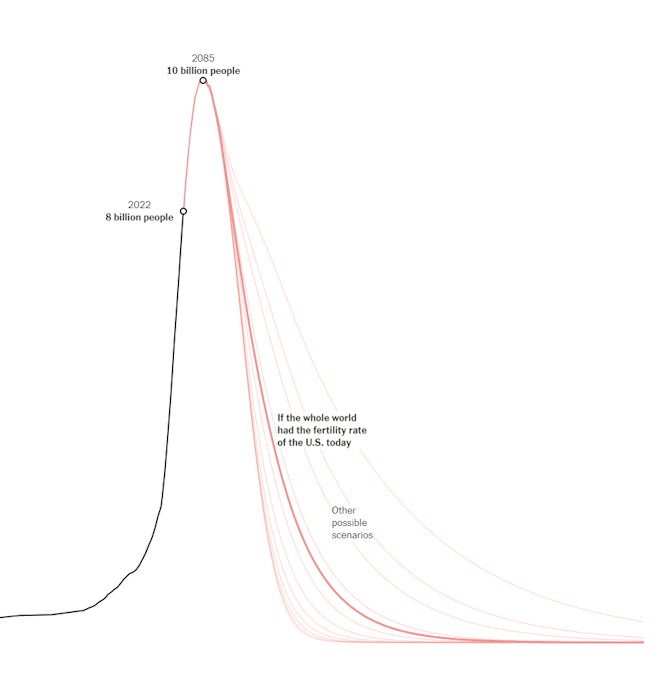425. World population beyond 2100
What will happen to the world population after it peaks later this century? If current trends in fertility continue, we’ll head into a period of dramatic population contraction.
There have long been concerns that there are too many people on our planet. Eight billion people use a lot of resources, create a lot of pollution, emit a lot of greenhouse gases, and occupy a lot of space, crowding out every other terrestrial species.
Happily for the planet, fertility rates all over the world have fallen dramatically over the past 50 years or so. According to the United Nations’ latest data, the global average now is about 2.1 (children born per woman), the rate needed to maintain a constant population, and it will continue falling.
In most places, fertility rates peaked before 1970 and have been falling ever since. 20% of countries have fertility rates below 1.4 and in a few the rate has fallen below 1 (Hong Kong, South Korea, Taiwan).
Africa has the highest fertility rates, but even there, rates have fallen substantially since the 1970s and are predicted to continue to fall.
The upshot of all this is that global population is expected to peak at about 10 billion people in around 2080. The huge majority of that growth will have occurred in 300 years, with population not reaching 1 billion until 1800.
There are plenty of graphs on the internet showing global population growing rapidly since 1800 and peaking in around 2100, but almost none of them show what is likely to happen after that. What is likely to happen after that is quite stunning. Unless there is a dramatic reversal in fertility rates, the global population will crash about as rapidly as it has boomed for the last 300 years. The graph below is from a 2023 article in the New York Times.
That is quite mind blowing. Here are some obvious implications that occur to me.
- The current huge population of humans will have been just a brief blip in the history of the world, or even in the history of humanity.
- Within 300 years, our pressure on the earth’s resources and environment will have been substantially reduced. Whatever we haven’t destroyed irreversibly by then will have a chance of recovering.
- We’ll reach a point where there will be plenty of resources to go around (again). Any ongoing poverty won’t be due to an overall lack of resources.
- The social and economic changes and pressures during a period of rapidly falling populations will be enormous. It’s hard to imagine them all, but surely they’ll be very big.
- Any group or country that is able to maintain a relatively high fertility rate could come to dominate the global population.
- There will surely be social, policy and perhaps scientific innovations to prevent populations falling to the extremely low levels predicted in the graph (approaching zero).
Suddenly, population decline has become newsworthy. Countries like South Korea and Japan are already grappling with it, with houses being abandoned, schools closing and services struggling to find employees. But their present concerns will soon enough spread to the whole world.

Thank you, David, for presenting this information for wider attention. In one way, it is the best environmental news I’ve heard in a long time. The other way, as you point out, it could become a major social threat. Humans often talk of “managing” wild and feral populations of animals. We’ve hardly begun to think about managing our own population. The Chinese 1-child policy was withdrawn because of the problems it created. So, what is to be done? I hope that the academic community and their funders will give this developing problem the attention it deserves before the problems force themselves upon us.
Thanks John. I think the social impacts will be absolutely massive.
Our recent history has been one of increasing population. When my grandparents retired they had on average 4 children of a working age, which meant a comfortable retirement. We’re now seeing a shortage of working people to support the retired and the implications of that. It is hard to imagine what life will be like in an era of shrinking populations. One can only wonder what land prices (residential and agricultural) will do when the population stabilizes and then declines.
I think we can confidently predict what land prices will do when population declines. They will fall, and probably fall dramatically.